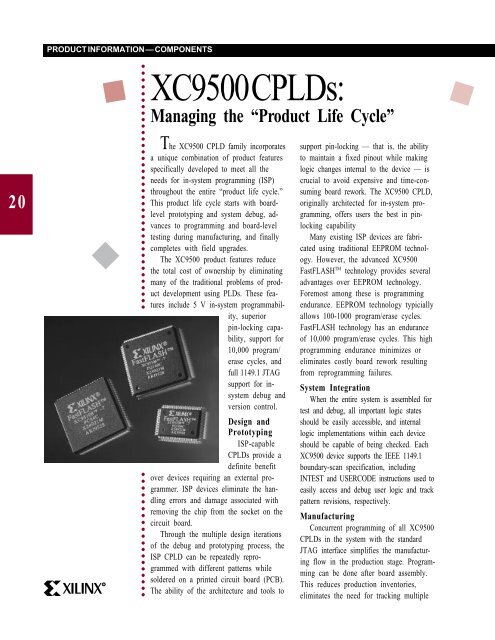VHDL Made Easy! - Xilinx
VHDL Made Easy! - Xilinx
VHDL Made Easy! - Xilinx
- TAGS
- vhdl
- xilinx
- www.xilinx.com
You also want an ePaper? Increase the reach of your titles
YUMPU automatically turns print PDFs into web optimized ePapers that Google loves.
20<br />
PRODUCT INFORMATION — COMPONENTS<br />
R<br />
○ ○ ○ ○ ○ ○ ○ ○ ○ ○ ○ ○ ○ ○ ○ ○ ○ ○ ○<br />
○ ○ ○ ○ ○ ○ ○ ○ ○ ○ ○ ○ ○ ○ ○ ○ ○ ○ ○ ○ ○ ○ ○ ○ ○ ○ ○ ○ ○ ○ ○ ○ ○ ○ ○ ○ ○ ○<br />
XC9500 CPLDs:<br />
Managing the “Product Life Cycle”<br />
The XC9500 CPLD family incorporates<br />
a unique combination of product features<br />
specifically developed to meet all the<br />
needs for in-system programming (ISP)<br />
throughout the entire “product life cycle.”<br />
This product life cycle starts with boardlevel<br />
prototyping and system debug, advances<br />
to programming and board-level<br />
testing during manufacturing, and finally<br />
completes with field upgrades.<br />
The XC9500 product features reduce<br />
the total cost of ownership by eliminating<br />
many of the traditional problems of product<br />
development using PLDs. These features<br />
include 5 V in-system programmability,<br />
superior<br />
pin-locking capability,<br />
support for<br />
10,000 program/<br />
erase cycles, and<br />
full 1149.1 JTAG<br />
support for insystem<br />
debug and<br />
version control.<br />
Design and<br />
Prototyping<br />
ISP-capable<br />
CPLDs provide a<br />
definite benefit<br />
over devices requiring an external programmer.<br />
ISP devices eliminate the handling<br />
errors and damage associated with<br />
removing the chip from the socket on the<br />
circuit board.<br />
Through the multiple design iterations<br />
of the debug and prototyping process, the<br />
ISP CPLD can be repeatedly reprogrammed<br />
with different patterns while<br />
soldered on a printed circuit board (PCB).<br />
The ability of the architecture and tools to<br />
support pin-locking — that is, the ability<br />
to maintain a fixed pinout while making<br />
logic changes internal to the device — is<br />
crucial to avoid expensive and time-consuming<br />
board rework. The XC9500 CPLD,<br />
originally architected for in-system programming,<br />
offers users the best in pinlocking<br />
capability<br />
Many existing ISP devices are fabricated<br />
using traditional EEPROM technology.<br />
However, the advanced XC9500<br />
FastFLASHTM technology provides several<br />
advantages over EEPROM technology.<br />
Foremost among these is programming<br />
endurance. EEPROM technology typicially<br />
allows 100-1000 program/erase cycles.<br />
FastFLASH technology has an endurance<br />
of 10,000 program/erase cycles. This high<br />
programming endurance minimizes or<br />
eliminates costly board rework resulting<br />
from reprogramming failures.<br />
System Integration<br />
When the entire system is assembled for<br />
test and debug, all important logic states<br />
should be easily accessible, and internal<br />
logic implementations within each device<br />
should be capable of being checked. Each<br />
XC9500 device supports the IEEE 1149.1<br />
boundary-scan specification, including<br />
INTEST and USERCODE instructions used to<br />
easily access and debug user logic and track<br />
pattern revisions, respectively.<br />
Manufacturing<br />
Concurrent programming of all XC9500<br />
CPLDs in the system with the standard<br />
JTAG interface simplifies the manufacturing<br />
flow in the production stage. Programming<br />
can be done after board assembly.<br />
This reduces production inventories,<br />
eliminates the need for tracking multiple

















